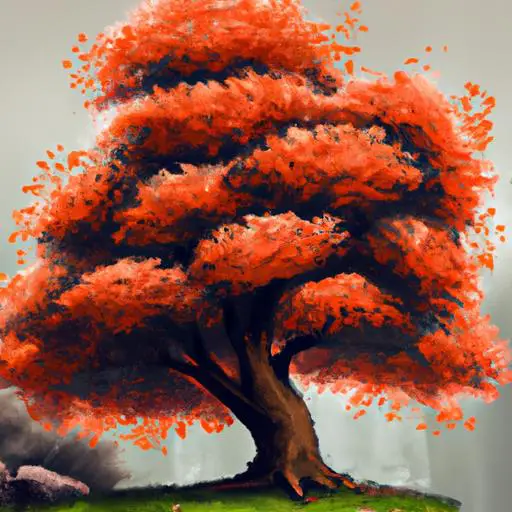Have you ever wondered how a maple tree produces those beautiful red and orange leaves in the fall? Or how a single tree can provide a huge bounty of syrup? If so, then you’ll be fascinated to discover the incredible process of how maple trees reproduce! In this article, we’ll take a closer look at the science behind maple tree reproduction.
We’ll explore what a maple tree is, how they reproduce, the process of seed dispersal, germination of maple tree seeds, as well as the benefits of maple tree reproduction.
We’ll also discuss how maple trees benefit humans, so you can get a better understanding of the importance of these trees.
So, let’s dive in and discover the fascinating process of how maple trees reproduce!.
Table of Contents
Short Answer
Maple trees reproduce through a process called pollination.
Pollen is released from the male flowers and is then transferred to the female flowers on the same or other maple trees.
The pollinated female flowers then develop into a fruit, which contains seeds.
When the fruit matures, it splits open and the seeds are dispersed.
The seeds can then germinate and grow into new maple trees.
What is a Maple Tree?
A maple tree is a deciduous tree that is native to parts of the Northern Hemisphere, including Europe, Asia, and North America.
There are more than 100 species of maple trees, with the most well-known being the sugar maple and the red maple.
Maple trees are characterized by their large, lobed leaves, which can range in color from bright green to red or yellow in the fall.
They can grow anywhere from 30 to 120 feet tall and are often found in yards, parks, and forests.
Maple trees are also a popular choice for ornamental landscaping, as they are attractive and easy to care for.
How Do Maple Trees Reproduce?

Maple trees are able to reproduce in two ways: seed dispersal and vegetative reproduction.
Seed dispersal is the process by which the trees seeds are spread away from the parent tree, usually by wind or animals.
The seeds are contained in a winged fruit called samaras, which are designed to spin away from the tree when they are ripe.
Once the seeds are dispersed, they can germinate in the soil and eventually grow into new maple trees.
This method of reproduction is advantageous for maple trees because it allows them to spread across a wide range of habitats.
In addition to seed dispersal, maple trees can also reproduce through vegetative reproduction.
This process involves the tree sending out roots below the soil that sprout and form new trees.
This method is advantageous because it allows the trees to reproduce without having to rely on external sources like wind or animals to disperse their seeds.
Overall, maple trees are able to reproduce both through seed dispersal and vegetative reproduction.
Each method has its own advantages and disadvantages, but both serve the same purpose: to allow the species to spread across a wide range of habitats.
With these two methods of reproduction, maple trees can continue to thrive and increase their population.
Seed Dispersal of Maple Trees
Maple trees reproduce through a combination of seed dispersal and vegetative reproduction.
The most common method of seed dispersal for maple trees is by producing samaras, which are winged fruits.
These fruits develop from the flowers of the tree and, when ripe, spin away from the tree and are carried away by the wind or animals.
The samaras hold the seeds inside, which are then dispersed and can germinate in the soil.
The process of seed dispersal is essential for the survival of the maple tree species.
By dispersing the seeds in this way, the tree is able to spread across a wide range of habitats, allowing the species to thrive in different areas.
The samaras are also adapted to ensure the seeds are able to travel far distances, with their wings helping them to catch the wind and be carried away.
The dispersal of the maple trees seeds is an incredibly fascinating process.
It is a vital part of the species survival and a crucial step in the life cycle of the tree.
Without this process, the maple tree would not be able to populate the environment and would eventually become extinct.
Germination of Maple Tree Seeds

Maple trees reproduce through a combination of seed and vegetative reproduction.
They produce their seeds in the form of samaras, which are winged fruits that spin away from the tree when they are ripe.
The samaras are dispersed by wind or animals and then germinate in the soil.
When the samaras land in the soil, the seeds inside begin to germinate.
This process begins with the seed absorbing water, which activates the dormant seed embryo.
The seed embryo then begins to grow and eventually produces a seedling.
The seedling will go through a period of growth and development before it becomes a mature tree.
The rate of germination is affected by several factors, such as the amount of moisture in the soil, the temperature, and the amount of light the seed receives.
The seed must receive enough sunlight for photosynthesis, or it will not grow.
The seed also needs to have a moist environment to break dormancy and grow.
The temperature must be in the right range for the seed to germinate, which is why maple tree seeds usually germinate in the spring when temperatures are optimal.
Once the seedling has emerged from the soil, it will begin to develop its root system and leaves.
The seedling will continue to grow and eventually become a full-fledged maple tree.
The process of maple tree reproduction is fascinating and complex.
By using both seed and vegetative reproduction, maple trees are able to spread across a wide range of habitats.
Vegetative Reproduction of Maple Trees
Maple trees are capable of reproducing through vegetative reproduction, which is the process of a plant creating new plants without the need for seeds.
This type of reproduction is not only beneficial to the maple tree, but it also helps the species to spread and thrive in a wide range of habitats.
Vegetative reproduction in maple trees occurs when the tree sends out root shoots that sprout and form new trees.
These root shoots are called rhizomes, and they are capable of growing into a new tree even when separated from the original tree.
This means that even if the original tree is destroyed, the species can continue to reproduce and spread.
The advantage of vegetative reproduction is that it helps the species to survive and spread even in the face of environmental changes.
This is because it ensures that the species will still be able to reproduce, even if the original tree is destroyed.
The process of vegetative reproduction is also beneficial for the maple trees health and longevity.
By sending out root shoots, the tree is able to spread its resources and nutrients more efficiently.
This helps it to stay healthy and strong, and also allows it to live longer than it would if it only relied on seed reproduction.
In addition to providing the maple tree with a way to spread and survive in a variety of habitats, vegetative reproduction also helps the species to thrive in more difficult conditions.
By sending out root shoots, the tree can access nutrients that may not be available to it through seed reproduction.
This helps it to survive and thrive in harsher climates and environments.
Vegetative reproduction is an essential part of the maple trees survival and its ability to spread across a range of habitats.
By sending out root shoots and forming new trees, the species is able to stay strong and healthy, and also ensure its continued survival even in the face of environmental changes.
Benefits of Maple Tree Reproduction

Maple tree reproduction is an essential part of the species survival and success.
Through the combination of seed dispersal and vegetative reproduction, maple trees are able to spread across a wide range of habitats.
This allows the species to quickly adapt to different environments and changing climates.
The reproductive process also helps maintain the genetic diversity of the species.
As the seeds are dispersed, they bring new genetic material to new habitats, and this helps the species to thrive in a variety of conditions.
The process also ensures that the species can continue to survive in the face of potential threats, such as disease or extreme weather.
The vegetative reproduction of maple trees also has its benefits.
By sending out roots, maple trees are able to form new trees that are clones of the parent tree.
This ensures that the species can continue to thrive, even if some of the individual trees in a particular area are lost.
It also ensures that the species can quickly adapt to changing conditions and can quickly spread to new areas.
Overall, maple tree reproduction is a vital part of the species success and survival.
Through the combination of seed dispersal and vegetative reproduction, maple trees are able to quickly adapt to different habitats, maintain genetic diversity, and form new trees.
These processes ensure that the species can continue to thrive in the face of potential threats.
Human Benefits of Maple Trees
Maple trees are incredibly beneficial to humans and the environment.
Not only do they provide food and shelter for a wide range of animal species, but they also provide us with a number of resources that can be used to better our lives.
Maple trees provide us with maple syrup, a highly sought-after sweetener.
They are also a major source of lumber, which is used to create furniture, flooring, and other building materials.
The trees also help to keep the environment healthy by providing shade and preserving soil moisture.
This helps to reduce soil erosion, which can be a major problem in areas with heavy rainfall.
Additionally, their canopies provide a home for a variety of wildlife and birds.
This helps to maintain a healthy and biodiverse ecosystem.
Finally, maple trees can help to reduce air pollution.
Their leaves absorb airborne pollutants and carbon dioxide, which helps to improve air quality.
This is especially beneficial in urban areas, as the trees can help to reduce the amount of smog and other pollutants that are emitted into the environment.
In short, maple trees provide a multitude of benefits to both humans and the environment.
From providing food, shelter, and lumber to cleaning the air and preserving soil, these trees are an invaluable resource that should be protected and respected.
Final Thoughts
Maple trees are a fascinating species, and their ability to reproduce both sexually and asexually is an incredible feat.
By understanding the process of maple tree reproduction, we can better appreciate and utilize the many benefits that these trees offer us.
From providing us with their delicious syrup to cleaning our air, maple trees have proven to be an invaluable part of our environment.
We can all do our part to ensure that the majestic maple tree continues to flourish and benefit us all.


